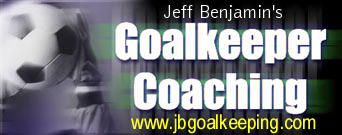
|
"Outstanding keeper instruction. This is a must for goalkeepers and coaches." — Ottawa Internationals S.C. web site, Ottawa, Canada |
 |
 |
|
|
Top |
Next: Training Sessions
|
We are not going to go into the history of the way that the laws about the goalkeeper have changed, but we have to emphasize certain points about why the laws were changed... we believe it is important to understand the purpose of the laws in order to apply them correctly.
-- Evans and Bellion, For the Good of the Game
It is very difficult to play a game if you don't know and understand the rules. A good goalkeeper -- or field player, or coach, for that matter -- needs to know the Laws of the Game of soccer in order to perform at their best. This section is not intended to be a complete primer on the Laws, but addresses specific areas that relate to goalkeeping. The black and white text of the Law book is supplemented by years of experience and tradition that impact how the game is called and how the players play.
Law 1 - The Field of Play
Although the soccer field and its markings are often taken for granted by the players unless there is something obviously wrong, it can be helpful for the goalkeeper to know the dimensions of the lines on the field. A keeper will use these lines more than anyone else on the field to determine their positioning. Before the game, scan the lines and make sure they are all square and at proper distances. In particular,Law 4 - The Players' Equipment
Law 4 says "each goalkeeper wears colors which distinguish him from the other players, the referee and the assistant referees." This is the only requirement. Tradition allows the keeper to use equipment that is not specified for field players: gloves, long pants, or hats. The referee always has final say on what is allowable; if he deems something to be unsafe, it may not be worn.Law 8 - The Start and Restart of Play
Law 8 has a section called "Special Circumstances" that players, especially goalkeepers, should be aware of. It has to do with the placement of the ball on free kicks inside the goal area. Essentially, any free kick for the defense inside their own goal area is like a goal kick - it may be taken from anywhere in the goal area and must leave the penalty area before it is in play.For indirect free kicks for attackers in their opponents' goal area, the kick is taken from the goal area line parallel to the goal line at the point nearest to where the foul occured. Thus, no free kick can be taken from closer than six yards to the goal. More on this special circumstance below the section on free kicks.
Law 9 - The Ball In and Out of Play
Although he is (usually!) a bit more mobile than the goalposts, the referee is considered to be part of the soccer field when it comes to play. A ball rebounding off the referee (or off an assistant referee, if for some reason they are on the field of play) is still in play.Law 10 - The Method of Scoring
Simple as it seems, I have come across players who did not know that the entire ball must be past the goal line for the goal to count. The outside of the chalked line is the true boundary; the whole of the ball must pass over this boundary. The back of the goalposts should be set even with the outside of the goal line, so that the goal frames are actually considered on the field of play, and the ball must completely clear the posts and crossbar to be a goal.Law 12 - Fouls and Misconduct
Calls involving fouls and misconduct are the most argued about and disputed in any game of soccer. All players need to remember that all fouls and misconduct are strictly in the opinion of the referee. If the referee has made a decision, it seldom does any good to argue about it. Better to let it go and concentrate on the task at hand (setting the defensive wall, preparing for the penalty kick, etc.).Direct Free Kicks
The goalkeeper is subject to the same Laws regarding kicking, tripping, holding, pushing, tackling, etc. as all other players on the field. Although the Laws don't give the keeper any special privileges, most referees realize that keepers often put themselves at considerable peril in the thick of play and give them some leeway. However, don't use that as license to commit mayhem in the penalty area.An example of this is the goalkeeper using the knee when going for high balls. As stated in the section on catching high balls, the knee is used to generate height and provide some protection, not as a weapon. A referee who feels the keeper's knee is being used dangerously can call the keeper for jumping or charging... and the result would be a penalty kick, if not a yellow or red card in addition.
Indirect Free Kicks
There are four offenses in Law 12 specifically aimed at the goalkeeper. An indirect free kick is awarded to the opposing team if the keeper, in the penalty area, commits one of the following:- Takes more than six seconds, after controlling the ball with the
hands, to release the ball into play.
Six seconds is not hard and fast; referees are instructed not to count or signal publicly, and first offenses are usually given verbal warnings. But six seconds is plenty of time to settle the ball, jog up to the edge of the penalty area and find an outlet. During this six seconds, the goalkeeper can move anywhere in their penalty area. Don't get caught by this Law - instead, use it as a reason to work on quick distribution to start the counterattack.
- Touches the ball again with the hands after releasing it into play,
before the ball has been touched by another player.
Bouncing or softly tossing and catching the ball are not considered "releasing the ball into play", but why even risk it? Bouncing the soccer ball is a holdover from olden days where a goalkeeper was able to move in the penalty area if they bounced the ball (similar to a basketball dribble). That rule no longer applies, so once the keeper has the ball safely in their hands, they should hang on to it until they are ready to deliver it downfield.
- Touches the ball with the hands "after it has been deliberately
kicked to him by a team-mate".
The italicized above is a direct quote from the FIFA Laws, and is often misunderstood. Remember the intent of the Law, which is to prevent time wasting by the defense. As such, only a deliberate kick by a teammate, either to the goalkeeper or to a place where the goalkeeper can safely pick the ball up, should be penalized. An accidental deflection off a defender's foot, or a missed clearance that falls to the goalkeeper should not be penalized.
But as always, "deliberate" is in the opinion of the referee. So
 if in
doubt, don't pick the ball up - unless the ball is at risk of
going into the net if you don't use your hands! In that case, better to
concede an indirect free kick than a goal.
if in
doubt, don't pick the ball up - unless the ball is at risk of
going into the net if you don't use your hands! In that case, better to
concede an indirect free kick than a goal.
- Touches the ball with the hands directly from a throw-in from a
teammate.
The goalkeeper may still be used as a target for a throw-in, but they must handle the ball with their feet like any other player.
An indirect free kick can also be given to the goalkeeper's team if an opponent prevents the ball from being released into play by the keeper. This is seldom called, but it's good to know the keeper gets a little protection in the Laws!
Finally, it is an indirect kick if an opponent plays in a dangerous manner. This applies not only to endangering an opponent (e.g. high boot) but also to endangering one's self (this is why the player on the ground is called for this - they have put themselves in harm's way). By tradition, the goalkeeper is given leeway here and is allowed to put themselves in positions that would be dangerous for any other player on the field (for example, sliding at the feet of an attacker).
Law 13 - Free Kicks
Direct and indirect kicks differ in one respect: a direct kick that goes into the net without being touched is counted as a goal; an indirect kick must be touched by another player (on either team) in order to count. Indirect kicks are signalled by the referee raising one arm straight up above his head. Look for this signal; if it is not given, assume a direct kick. If in doubt, ask the referee -- most will also inform you verbally.Occasionally an attacker will not realize a kick is indirect and shoot straight at the net. In this case, if it is a difficult save, the keeper should just let the ball go in rather than risk deflecting the ball in themselves and providing the touch that let the goal stand. But be absolutely sure it is indirect and nobody but the shooter touched the ball. If in doubt, try to make the save. (By the way, an indirect kick that goes into the net without being touched is awarded a goal kick.)
Any free kick from within the penalty area must leave the penalty area before it is considered in play.
Everybody knows that the defenders must be 10 yards from the spot of a free kick, but what about an indirect free kick that is less than 10 yards from the goal (subject to those "special circumstances" in Law 8)? In this case, defenders are permitted to be closer than 10 yards provided they are on the goal line and between the goal posts. This kind of situation doesn't happen much, but it can come up and it would be wise if the keeper knows how to set the defense if this happens - see Setting a Wall under "Advanced Tactics" for more on this.
Law 14 - Penalty Kicks
The only time during a game a goalkeeper should be standing on the goal line is during a penalty kick, and that is only because the Law says so. Goalkeepers are allowed to move side-to-side along the goal line, but not to move forward until the ball is struck.Why is this Law disregarded so often? Moving forward offers the goalkeeper a host of advantages, from a better catching position to narrowing the size of the net the shooter sees. Why isn't it called more often? Tradition, mostly. This is one of the most inconsistently called Laws in the book, especially for one that isn't even a matter of opinion. Until FIFA decides referees are going to enforce this one to the letter, or the rule is rewritten, we will have to live with the inconsistency. For more on penalty kicks, see the Penalty Kick page.
|
|
Top |
Next: Training Sessions
|